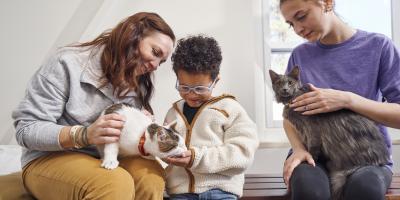Why Does My Cat Headbutt Me?


Cats have a reputation as being independent and often standoffish, but many cat owners can speak to the opposite – cats are loving and thrive on cuddles. Cats show love in many ways, but one of the most endearing cat behaviors is cat headbutting, also known as bunting. Learn why cats headbutt, what it means when they bump heads with you, and how to respond to such a sign of affection.
Why Do Cats Headbutt?
Cats that bump heads with you aren’t angry or being aggressive; in fact, they’re more than likely doing it as a sign of affection. Scent glands are on a cat’s cheeks, forehead, and chin, and when they bump heads with you, they release pheromones they use to mark territory, express trust, and more. A friendly headbutt might just be a simple way of saying hello, too.
What Does it Mean When a Cat Headbutts You?
Head bunting, or cat headbutting, is a natural cat behavior, although it might seem strange to humans. If your cat presses their head into yours, it could mean:
- They’re showing affection. Headbutting is one of the subtle ways cats show affection or love. They can’t smile or give you hugs, but a bunting is essentially the same gesture in the cat world.
- They want to say hi. A cat bunt can simply serve as a “hello.”
- They trust you. Headbutting is a comforting, trusting behavior. It means they feel safe and relaxed with you, and even emotionally connected. It’s a highly vulnerable move.
- They want your attention. If you get a cat bunt while you’re in the middle of something, they might be asking for playtime, food, or some pets. Your cat might even headbutt your phone to let you know they need you.
- They’re marking you as territory. Cats are territorial, but that doesn’t translate into aggression. By headbutting you, they’re lovingly marking you with their scent.
- They’re spreading their scent. Headbutting furniture, people, or other pets helps them spread their scent and feel more at home.
Differences Between Cat Headbutting, Nuzzling, and Cat Pressing Head on Things
Not all headbutting-related gestures mean the same thing in the feline world. There’s headbutting or bunting, nuzzling, and head pressing, which are nuanced behaviors. To help you read your cat’s body language better, here’s how to tell the difference:
- Headbutting or bunting: If your cat bumps you with their forehead and then snuggles their body up against you, they’re likely trying to express that they feel safe with you and trust you. They could also just be saying “hi” in cat language.
- Nuzzling: Nuzzling is like cat face snuggling. They’ll rub their face against you in a slow, soft way. It’s more gentle than headbutting and is a way for them to express love, mark their territory, or greet you. If your cat nuzzles you and then gently bites you, it’s usually a sign of affection and not aggression. Kittens tend to do this more than adult cats.
- Head pressing: If your cat is pressing their head against a wall or object continuously and firmly and while not sleeping, it’s not affectionate. They might be having a medical issue, and you need to contact your veterinarian immediately.
The difference between these cat behaviors can be subtle, so look at their tail movement and position to help you identify what’s going on. If they’re happy, their tail will be in the shape of a question mark. If something is off, their tail might be able to help clue you in, along with other behaviors.
Do Certain Cat Breeds Headbutt More Than Others?
Some breeds might headbutt more than others. Affectionate cat breeds tend to be more physically expressive and often show their love through bunting. Balinese, Cornish Rex, Oriental, Siamese, Singapura, Ragdolls, Maine Coons, and Burmese are all known as social and outgoing cats that love to give and receive affection.
Your cat’s personality will matter as much as the breed when it comes to how they show affection through bunts, headbutts, or other behaviors. The more confident and outgoing a cat is, the more likely they will bunt, but not always. If there is more than one cat in your house, the more confident cat is likely to do most of the headbutting. It’s instinct for cats to mark shared territory – aka you.
How to Respond to a Cat Headbutt
Now that you know that a cat headbutt or bunt is a sign of trust and affection, here’s how to respond to your cat to keep the bond between you strong:
- Return the gesture. There’s no need to go forehead-to-forehead with them, but you can lean in or gently press into them to give the affection back.
- Reward their affection. Pet them in their favorite spot, such as around their chins or behind their ears. They’ll show you that they enjoy it by leaning into you. A cat’s body language is a great indicator of how they’re feeling in the moment.
- Pay attention to them. Bunting can be a way to seek attention, not just give affection. If your cat is headbutting you while you’re doing something, it might mean that they need playtime or a pet.
Conclusion
Headbutting is an oddly adorable behavior unique to cats, but it’s a sign that they trust you. Respond accordingly, and you and your cat can form an even deeper bond.
For more expert tips on caring for your cat, explore our other cat routine care articles.
Related articles

Earn myPurina Rewards with Every Purchase
Use your points for treats, toys, and gift cards with myPurina app.



